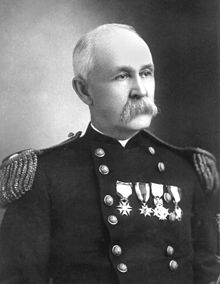George Miller Sternberg
George Miller Sternberg (born June 8, 1838 in Cooperstown , New York , † November 3, 1915 in Washington, DC ) was an American doctor (later Surgeon General of the US Army ) and a pioneer of bacteriology .
Sternberg was the son of the Lutheran pastor Levi Sternberg, who taught at the Hartwick Seminary in New York. The ancestors immigrated from the Palatinate in the early 18th century . Sternberg was taught in his father's school, interrupted by times when he himself taught in country schools or worked in a bookstore. He studied medicine at the College of Surgeons and Physicians of New York in Buffalo with the degree ( MD ) in 1860. During the Civil War he was a surgeon in the US Army and participated in the First Battle of Bull Run (where he was captured) and the Peninsular Campaign (where he was involved in the Seven Day Battle at Gaines Mill and Malvern Hill ) before he got typhoid fever and only served in hospitals. He achieved the rank of major during the Civil War and remained in the Army after the war. In 1865 he married Louisa Russell, who died of cholera a few years later. Sternberg was stationed in Kansas , where he participated in the Indian Wars and collected fossils on the side. In 1866 he became a captain. In 1870 he was transferred to Governors Island , New York, and spent three years in Fort Barrancas , Florida . During this time he had many patients with yellow fever , which he also fell ill with himself. He published about it and was soon considered a specialist in it. In 1875 he became a major and came to Washington DC in 1879 and was assigned to the Yellow Fever Commission, which studied the disease in Cuba , among other places . In 1880 the commission advocated awaiting further research into bacteriology.
Sternberg made important advances in bacteriology. In the USA he confirmed Plasmodium as the cause of malaria and the causative agents of typhoid and tuberculosis, of which he was the first to take photos under the microscope. In 1881, independently of Louis Pasteur , he isolated pneumococci as the cause of pneumonia. In 1892 his Manual of Bacteriology appeared , the first textbook in the field, which presented the new developments by Robert Koch , Pasteur and others. He also dealt with disinfection as one of the first in the USA, about which he published an award-winning article in 1886. When cholera broke out in Hamburg in 1892 , he successfully prevented it from spreading to the USA.
In 1893 he succeeded Charles Sutherland Surgeon General in the US Army (with promotion to Brigadier General), which he remained until his retirement in 1902. Among other things, he founded the Army Medical School in 1893 , later the Walter Reed Army Institute of Research , and the US Army Nurse Corps . He was on the official typhoid and yellow fever commissions (partly headed by Walter Reed ) to combat these diseases, which also claimed many victims in the US Army, for example in the Spanish-American War .
His brother Charles H. Sternberg , who worked for him on a ranch in Kansas, became a famous fossil collector. George Sternberg himself was also a fossil collector, but did not publish about it. According to fossils he collected , Joseph Leidy described Xiphactinus in 1870 .
Web links
| personal data | |
|---|---|
| SURNAME | Sternberg, George Miller |
| BRIEF DESCRIPTION | American doctor |
| DATE OF BIRTH | June 8, 1838 |
| PLACE OF BIRTH | near Cooperstown , New York |
| DATE OF DEATH | November 3, 1915 |
| Place of death | Washington, DC |
